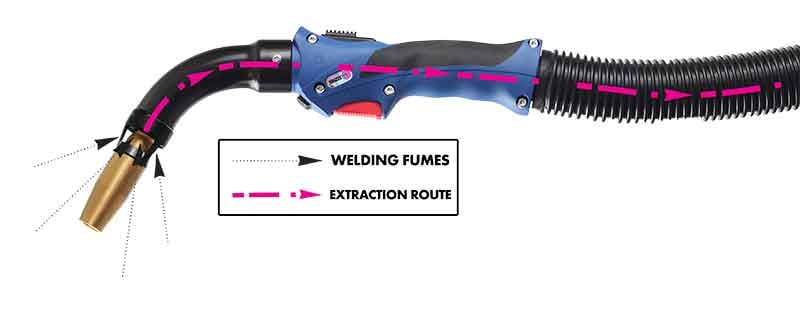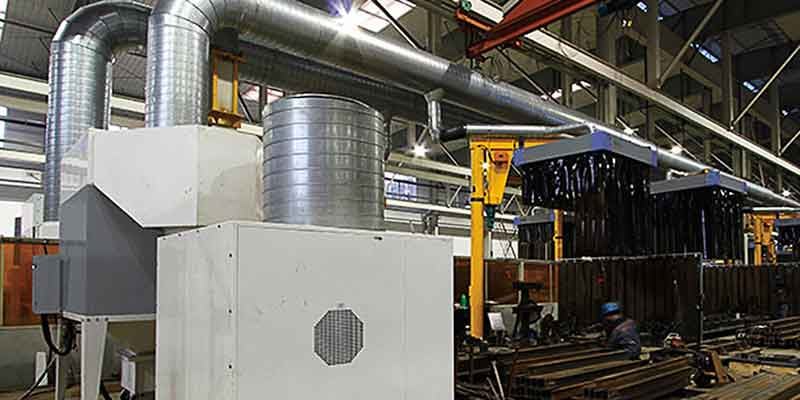When you start looking at fume extraction solutions, there are a multitude of engineered possibilities to assist in the capture of weld fume. These are typically the most effective way of dealing with weld fume in the workplace apart from removing the welding process.
Among engineered options, fume extraction controls divide into different sections. They're all LEV per se, meaning local exhaust ventilation.
These types of fume extraction options include:
- Downdraft tables and fume hoods
- Fume Extraction Arms
- Fume Extraction Welding Guns
- Robotic Source Fume Extraction
- Portable Fume Extraction System
- Multi-station Fume Extraction Systems
- Centralized Fume Extraction Systems
Because welding fume is heated by the process, it goes up and mixes with the air naturally. Each of these fume extraction options is effective in different ways and involve various levels of investment and energy need.
Downdraft Tables and Fume Hoods
You put the hood above the welding process, and you extract a high volume of air. Your aim with a solution like this is to reduce the amount of smoke escaping the hood. These are the current industry standard for robotic welding applications. It was one of the first solutions created and is widely used.
This approach requires a large investment both in structure and ventilation systems and does not protect the human in the zone between welding and hood. Moving parts and jigs under the hood become a challenge and a potentially expensive operation.
Downdraft tables, which can be used for both welding and cutting processes, come in all size and shapes and are efficient in certain conditions. They come in all sizes and shapes, and they are efficient in certain conditions. Since smoke goes up, and the downdraft table pulls smoke down, you have to pull really hard on the airflow to actually pull down and capture welding and cutting fumes. This can make for a high amount of energy used to ventilate your plant.
/Webinars/Fume%20Extraction/Weld-Fume-Source-Capture-Graphic.jpg?width=600&name=Weld-Fume-Source-Capture-Graphic.jpg)
It takes about 100 cubic meter (m3) to do smoke extraction at the source via a welding gun and about 1000 m3 to use flex arms.
As you are farther away from the weld smoke source, you need higher volumes of air to both capture weld fumes and replace the atmosphere with clean air.
For instance, more than 2000 m3 is needed for downdraft tables, and many thousands for general ventilation.
The scale of energy needed for each of the technologies possible varies greatly. Be certain to factor that in to the solutions you are considering.
Fume Extraction Welding Guns
High vacuum smoke attraction MIG torch is from an energy and capture efficiency standpoint the most effective way to capture weld fume. It's the closest to the source. If you look at the graphic below of the MIG torch, you see the welding nozzle, it's a regular standard nozzle. The black arrows is where the smoke is going in, and it's following a path all the way down to the vacuum system - represented by the pink arrows. Around the nozzle you create a vacuum and pull the smoke right there at the source. This places your extraction about 60 - 75 millimeters or 2-3 inches away from the welding process. Now, people often say, "Oh, it's too close to the process. I'm going to have welding quality issues." That's become less of a problem with more recent generations of fume extraction welding guns. Newer designs put the fume extraction far enough from the process while extracting enough volume that you're not interfering with the shielding gas or the welding process.
Around the nozzle you create a vacuum and pull the smoke right there at the source. This places your extraction about 60 - 75 millimeters or 2-3 inches away from the welding process. Now, people often say, "Oh, it's too close to the process. I'm going to have welding quality issues." That's become less of a problem with more recent generations of fume extraction welding guns. Newer designs put the fume extraction far enough from the process while extracting enough volume that you're not interfering with the shielding gas or the welding process.
We divided the two processes so that the welder can weld and still extract the smoke as he goes. It's the best protection for the welder because it's built in. He or she is using the tool that's also extracting smoke, so there's no human choice in placing the hood properly. It's right at the source all the time.
It can show efficiency all the way up to 99% in the best conditions. In most conditions, it still is extracting most of the smoke. It's good for all MIG processes, whether you're using solid wire, flux core, or metal core wire with any kind of shielding gas whether that is CO2, Argon, or others.
You don't have to change your welding process to implement MIG smoke extraction. It does require a special high vacuum to go along. Because this tool is very small, you have to pull really hard to overcome the restriction of the tool. So you need to make sure that the vacuum you're selecting is matching the welding gun you're buying. That is something you have to check in the process of testing or using different fume extraction MIG guns.
Here's a small video of the result with and without fume extraction.
Robotic Source Capture Fume Extraction
Historically, the industry standard has been hoods above the robots or local exhaust filtration and ventilation around the robot. There's no human close to the process, so the idea has generally been to catch the smoke later. This process involves a lot of air movement and power to move all that air. New technology being developed is trying now to extract right at the source on the robots, as well. Understanding the dissipation of weld fume as it rises still exposes workers outside the cell.
The fume, at this point, is captured right at the source through a special fume nozzle that's installed on the torch. It's good for all MIG processes. The efficiency is extremely high, too, because the tool doesn't have to be as restrictive as a manual fume extraction gun. This allows for a little more flow, but it does also require a high vacuum system to match the robotic MIG extraction kit.
This is also more useful as collaborative robots become increasingly popular in robotic welding applications. To put a hood above a cobot does not protect the operator and isn't ideal given the current approach to cobots - which is to keep it an adaptive and flexible solution. Local smoke extraction then becomes a very attractive option, and it is efficient when done properly.
Fume Extraction Arms
Flex arms use medium to low vacuum pressure as opposed to high vacuum in MIG welding source capture to extract weld fume. So the fume is captured through the hood, through a large hose and into the filter. It's a good protection for the welder in optimal conditions, and is a solution many manufacturers are familiar with.
Assuming that the flow is right and that the position of the hood is well placed above the smoke, and also assuming that the welder isn't coming between the torch and the hood, it is a good protection option. Some processes don't allow a built-in tool into the welding gun, like stick welding or TIG welding. This makes fume extraction arms a necessity if changing the process isn't feasible.
The big concern when using extraction arms is if you don't put the hood exactly above the welding process, it's not effective. If you put hoods everywhere in your plant, but they're left where they are by the wall, they're not effective. They're not built into the welding tool, so it's more reliant on that human interface.
Portable Fume Extraction Systems
If your plant has many welders and many processes, you might wonder, "Okay, how do I approach that? Do I buy single vacuum machine and single units, or do I go many units together, or do I go all out and put a central system?"
Each of the different approaches has upsides and downsides. If you're looking at single welding gun fume extraction unit, the entry level cost is the lowest. You are buying a simple machine, there's no setup time, there's no installation cost, it's dedicated, and it's moveable. These are all upsides of using a single machine. It is a flexible, cost effective solution that's giving you an immediate and tangible result.
/2019/Boletines%202019/Bolet%C3%ADn%20de%20prensa%20xFUME/xFUME%20Advanced.png?width=256&name=xFUME%20Advanced.png) On the downside, the maintenance is high because you have a single unit. Obviously, you have to make sure maintenance is done on that specific unit. So to think about having 20 welders with 20 different units, maintenance gets a little tricky to make sure that all 20 units are functional and filters are cleaned, changed and in good condition.
On the downside, the maintenance is high because you have a single unit. Obviously, you have to make sure maintenance is done on that specific unit. So to think about having 20 welders with 20 different units, maintenance gets a little tricky to make sure that all 20 units are functional and filters are cleaned, changed and in good condition.
The noise level is also a must to consider because you have a motor in each of these machines, they create noise and that accumulates. So the noise level is on the high side as opposed to a bigger system that's a farther away from the welders.
Portable fume extraction systems also vary in performance greatly and are specifically designed for high or low vacuum applications. Normally these solutions don't do both.
From top of line systems that provide high performance to the entry level with no adjustments and lower performance, there's a big range there. You have to be aware that performance is not always there with the single machines.
Sometimes they have limited functions, like no start/stop automatic, no filter cleaning, and you need to constantly monitor the unit beside the welder.
Multi-station Fume Extraction Systems
Multi-station fume extraction systems exist for both high and low vacuum application. The challenges are the same and the upsides and downsides the same, as well. For multiple units, there are wall-mounted units for flex arms that have five flex arms branched or the high vac system that connect between four to six on-tool fume extraction guns that connect on a power supply.
The cost ratio for these systems oftentimes is very attractive. Installation cost is low because you're still in the zone where you're close to your welders, and the systems are usually movable. If you change your production, you can take it and move it elsewhere and re-install it.
However, it's not as flexible as a single gun unit. If you have to do maintenance or if it's shut down, you have five or six or 10 welders that lack protection from weld fumes on top of the rest of the plant staff. You have to be aware that maintenance needs to be planned ahead because you will need to shut down multiple people welding and producing at the same time.
Centralized Fume Extraction Systems
Central system have a very high level of performance and low level of noise. Given the size and scale of this solution, maintenance and upkeep are both far lower per station over the lifespan of the solution.
But, initial cost, installation costs, electrical upgrades, and the risk of a complete shutdown are all part of the downsides to consider when looking at a central system.

They are also not very flexible, so when you choose a centralized fume extraction system, it's good for a certain amount of volume and static and flow. It's not something you can change without another large investment to do so.
When evaluation all the fume extraction options available, it's critical to look at your processes and ask a trustable solutions provider to provide scenarios and pick the one that's right for you. If you're starting with single stations, give it a try, test the solution, determine how it feels, what it does for you, how your workforce likes it, and then upgrade solutions as you go.
Remember to be flexible, and keep an open mind when looking at all the possibilities and work until you find the right solutions for you.
If you liked this blog, then we have the eBook for you! Download the Complete Guide to Fume Extraction (written by me!) by clicking the button below. No form fills to read. Simply click the button and begin.



